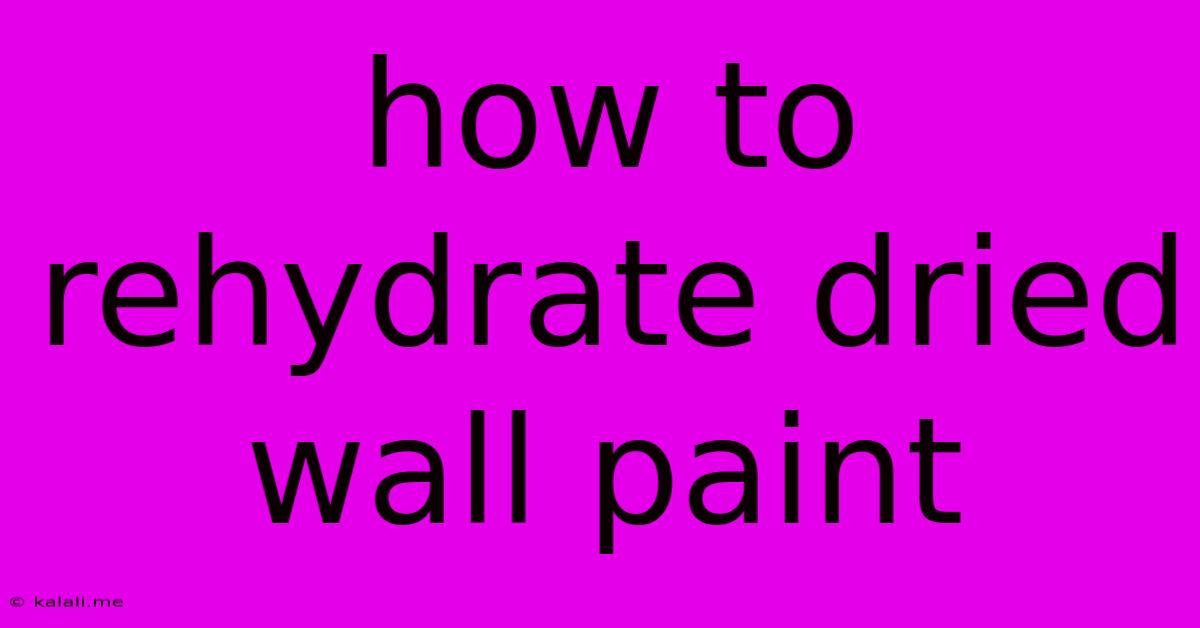How To Rehydrate Dried Wall Paint
Kalali
May 25, 2025 · 3 min read

Table of Contents
How to Rehydrate Dried-Out Wall Paint: A Step-by-Step Guide
Meta Description: Dried-out wall paint? Don't throw it away! This guide provides simple, effective methods to rehydrate your leftover paint, saving you money and reducing waste. Learn how to bring your paint back to life with easy techniques and helpful tips.
Dealing with leftover wall paint that's dried out can be frustrating. Before you reach for the bin, know that it's often possible to revive your paint and save yourself the cost of buying a new can. Rehydrating dried paint isn't always guaranteed to work perfectly, but with these methods, you have a good chance of success, especially if the paint isn't completely solidified. This guide will cover several techniques to bring your dried paint back to a usable consistency.
Assessing Your Dried Paint
Before starting the rehydration process, it's important to assess the condition of your dried-out paint. If the paint is completely hardened and cracked, forming a solid mass, your chances of success are low. However, if the paint is simply thick and crusty on the surface, you've got a better chance of restoring its usability. Look for signs of separation—a layer of skin on top or clumps of solidified paint. The more homogenous the paint looks, the better your odds.
Methods for Rehydrating Dried Wall Paint
There are several ways to attempt to rehydrate dried-out wall paint. Remember to always work in a well-ventilated area, and wear appropriate protective gear like gloves and eye protection.
1. The Gradual Addition of Paint Thinner or Mineral Spirits:
- This method is best suited for oil-based paints and alkyd paints.
- Slowly add a small amount of paint thinner or mineral spirits to the dried paint, stirring gently with a paint stick or mixing stick.
- Add the thinner in tiny increments, mixing thoroughly after each addition. Avoid adding too much at once, as this can thin the paint excessively.
- Continue this process until the paint reaches a usable consistency. Be patient; this may take some time.
2. The Water Method (for Water-Based Paints Only):
- This method is best suited for latex or acrylic paints.
- Add a small amount of clean water to the dried paint, stirring gently.
- Again, add water in small increments, mixing thoroughly after each addition. Too much water can ruin the paint's consistency.
- The goal is to achieve a smooth, creamy consistency.
3. Using a Paint Mixer:
- A paint mixer attachment for a drill can be helpful, especially if dealing with larger quantities of dried paint.
- Attach the mixer to your drill and slowly incorporate the thinner or water, as described above, allowing the mixer to thoroughly blend the ingredients.
Tips for Success
- Start Small: Always begin with a small amount of thinner or water, adding more gradually as needed. It's much easier to add more than to take it away.
- Patience is Key: Rehydrating dried paint requires patience. Don't rush the process.
- Strain the Paint: Once rehydrated, it's a good idea to strain the paint through a fine-mesh sieve or cheesecloth to remove any lumps or debris.
- Test the Paint: Before using the rehydrated paint on a large area, test it on a small, inconspicuous spot to ensure the consistency and color are satisfactory.
- Proper Storage: To prevent future paint from drying out, store it properly in an airtight container. Seal the can tightly and store it in a cool, dry place.
Rehydrating dried paint isn't a guaranteed success, but with the right techniques and a little patience, you can often salvage usable paint, saving money and reducing waste. Remember to always prioritize safety by working in a well-ventilated area and wearing appropriate protective gear.
Latest Posts
Latest Posts
-
Get The Answer You Re Looking For Added To The Web
May 25, 2025
-
How To Tell If Lp Tank Is Empty
May 25, 2025
-
Replacing A Gfci Outlet With A Regular
May 25, 2025
-
Why Does Ionization Energy Increase Across A Period
May 25, 2025
-
How To Get Key Unstuck From Door
May 25, 2025
Related Post
Thank you for visiting our website which covers about How To Rehydrate Dried Wall Paint . We hope the information provided has been useful to you. Feel free to contact us if you have any questions or need further assistance. See you next time and don't miss to bookmark.